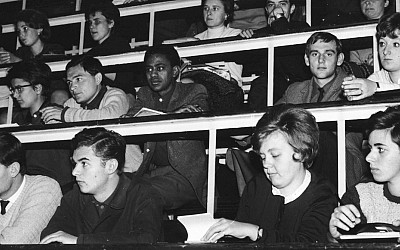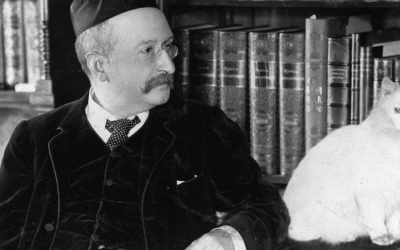Paul Guyer considers the centrality of the idea of autonomy to Kant's legacy.
In the Critique of the Power of Judgment (1790), the last of his three great critiques, Kant summed up his philosophical vision with the word “autonomy”: “In regard to the faculties of the soul in general, insofar as they are considered as higher faculties, i.e., ones that contain an autonomy, the understanding is the one that contains the constitutive principles a priori for the faculty of cognition (the theoretical cognition of nature); for the feeling of pleasure and displeasure it is the power of judgement ... ; for the faculty of desire it is reason, which is practical without the mediation of any sort of pleasure ... and determines ... the final end, which at the same time brings with it the pure intellectual satisfaction in the object.” But what did he mean by this complex statement?
“Autonomy” was originally a political term, signifying that a polis was free to provide its own constitution and laws rather than having to live under those imposed by another city. It also came to mean that a polis had a democratic constitution, or at least what passed for such among the stratified, slave-holding societies of ancient Greece. But this created tension, because law implies universality but democracy allows for variety, since if different cities are free to choose their own laws they might very well choose different laws.
Part of Kant’s legacy was certainly to broaden the ancient conception of autonomy, in the first instance from a political to a moral concept, defined in his Groundwork for the Metaphysics of Morals (1785) as including both the negative freedom of the will from determination by “alien causes” such as mere inclinations, and the positive freedom of the will to be “a law to itself (independently of any property of the objects of volition)”; and part of his legacy was to extend the scope of this term beyond the domain of action or practice altogether, thus to introduce an idea of self-given law or an inescapable human contribution to our knowledge of nature and an idea of autonomy in a domain that was in Kant’s mind linked more with pleasure than with knowledge, the domain of aesthetic experience and art.
But part of Kant’s legacy was also transmission of the tension within the idea of autonomy between universality and particularity, objectivity and subjectivity, conformity and individuality, leaving it an open question in epistemology, morality, and aesthetics whether autonomy is at odds with variety and relativity or rather provides the very framework for permissible variety and relativity. Many philosophers, for example Hegel and Nietzsche, have thought that Kant meant to exclude all scope for variety and individuality by his idea of autonomy as self-given law; I think that by this concept Kant meant to provide the framework within which permissible variety in action, taste, and even scientific theory could be allowed.
Kant’s idea of autonomy in theoretical cognition is that we are ourselves in some sense responsible for the most basic forms of knowledge, thus that we determine the way things appear to us and can therefore know how things must appear to us, but only at the cost of being barred from knowing how things really are. That conclusion has been controversial ever since Kant first stated it. The very first review of the Critique of Pure Reason (1781), published in 1782, charged that Kant’s “transcendental idealism” was just a new version of Berkeleleian “subjective” idealism, which reduced reality to ideas (esse est percipi, to be is to be perceived), and a few years later Friedrich Heinrich Jacobi famously asserted that without the idea of unknowable things in themselves he could not enter into the Kantian philosophy, but that with that idea he could not remain in it.
These objections stimulated the development of German idealism, above all the “absolute” idealism of Hegel, which tried to close the gap between the human representation of the world and the world itself by arguing that both knowledge and its object are aspects of a single, underlying, mind-like reality, Geist, so that there is no barrier between knowledge and its real object. However, as Frederick Beiser argued in his 2002 book German Idealism: The Struggle against Subjectivism, 1781-1801, this just raises a new question about the relation between Geist and any individual human mind, so absolute idealism no more guarantees the possibility of actual knowledge than does any other form of idealism.
Moreover, the German Idealists did not pause to examine Kant’s specific arguments for a gap between knowable appearances and unknowable things in themselves, and these turn out to be a mixed bag. First, Kant separated the autonomous laws of human knowledge into what he called the forms of intuition and the forms of concepts; the former, space and time, provide the framework within which particular objects are presented to us, and the latter, the categories of understanding such as substance and causation, provide the framework within which particular objects can be related to each other and classified into kinds.
His argument was then that only space and time as the forms of intuition are essentially subjective, while the categories are not intrinsically subjective but can yield knowledge only when applied to intuitions, so that any limitations on the objectivity of intuitions are transmitted to our use of the categories but are not inherent in the content of the categories themselves. Thus Kant argued that we could use the categories to think or conceive of things as they are in themselves even if without intuitions we cannot use them to know such things, and this was crucial for his view that we could replace traditional metaphysics with assertions about the freedom and immortality of the soul, the existence of the God, and even the receptivity of the natural world to our moral aims as conditions of the possibility of morality.
In turn, the idea that we can have a kind of knowledge rooted in practice rather than theory – that in this sense practice is an autonomous source of knowledge – was to be profoundly influential for many subsequent philosophers and movements, from Fichte to the later Wittgenstein and from American pragmatism to German critical theory, even though few of these accepted Kant’s distinction between appearances and things and themselves to begin with.
Further, even with respect to the forms of intuition, Kant employed a number of different arguments, open to different objections. In his first statement of transcendental idealism, not yet so named, namely his inaugural dissertation upon being appointed professor of logic and metaphysics at Königsberg in 1770, he suggested that the senses necessarily distort what they present to us, so insofar as knowledge depends upon the senses it is ipso facto barred from reality itself. This idea, rooted in the tropes of ancient scepticism and in the seventeenth-century theory of secondary qualities, certainly runs counter to modern evolutionary thought, which would assume that successful organisms could only have evolved senses that give them fairly reliable or at least not misleading information about their environment, and seems to have little to be said in its favour.
Kant did not repeat it in the Critique of Pure Reason. Instead, Kant there argued that the synthetic a priori – informative but universally and necessarily true – knowledge of the spatio-temporal structure of objects and of the structure of space and time themselves that we have both in general and specifically in branches of mathematics such as geometry could be explained in the case of representations that we make in accord with our own forms of intuition – thus autonomously – but not in the case of things in themselves, for in their case any agreement with our forms of intuition would be contingent rather than necessary. The problem here is that the subsequent course of physics has undermined Kant’s assumption that we have a priori knowledge of the physical applicability of any particular form of mathematics: not merely the development of formally valid alternatives to Euclidean geometry but the application of non-Euclidean geometry in twentieth-century physics seems to have exploded Kant’s assumption that we have a priori knowledge of the necessary application of Euclidean geometry and with that his inference that this is knowledge of appearances but not things in themselves.
So the legacy of Kant’s view of the autonomy of our knowledge of space and time seems to be chiefly the philosophies of mathematics that grew up in opposition to it, such as formalism and intuitionism. But Kant’s argument that the categories rather than the forms of intuition are in some sense forms of human thought rather than of nature itself and thereby introduce some degree of not only autonomy but also of subjectivity into scientific knowledge has had much more of an afterlife. Two points may be made here.
First, on Kant’s own account such categories as substance and causation that are supposedly given a priori by the structure of our own thought are themselves only the forms of more specific concepts of nature, and Kant is explicit that particular scientific theories about what kinds of substances and causation there are in nature are not given a priori, that views on these matters inevitably change in response to empirical data, and that the idea of a complete and final scientific theory of nature is never more than what he calls a “regulative ideal”. This idea, emphasised in the late nineteenth and early twentieth centuries by Neo-Kantian philosophers such as Hermann Cohen and Ernst Cassirer, has become a fixture of subsequent history and philosophy of science, as exemplified by such figures as Pierre Duhem, W V O Quine, Thomas Kuhn, and Hilary Putnam.
Second, however, some scientific developments, such as quantum mechanics and Big Bang cosmology, may seem to put into question whether even Kant’s most abstract concepts of substance and causation are really valid a priori. Here we might put Kant’s distinction between appearances and things in themselves to a new use, arguing, for example, that we might have theoretical reasons for accepting the idea of an uncaused initial singularity that in turn causes the rest of the universe but still cannot imagine or visualise such a thing because of the forms of our own intuition. Thus perhaps there is still life in Kant’s distinction between forms of intuition and forms of thought.
When it comes to practical – moral and political – philosophy, there can be little doubt of the continuing importance of Kant’s idea of autonomy, but there are still debates over how it is best interpreted. What relation between universal law and individual freedom does Kant have in mind with his concept of autonomy? According to Kant, morality requires that individuals act only on policies – he calls them maxims – that they could also will to be universal laws; hence the idea of the will being a law to itself. But Hegel famously argued that Kant’s requirement was vacuous, since with proper adjustments any maxim could be willed to be a universal law. Instead, he proposed, meaningful constraints on individual arbitrariness could only come from a well-ordered social structure, and individual freedom lies in the individual’s identification with his or her social role.
Others, such as Onora O’Neill, have argued that it is a mistake to assimilate Kant’s conception of autonomy with contemporary conceptions of autonomy as individual freedom at all, that Kantian autonomy is a matter of rationality or acting in accordance with the very idea of universality but that it has nothing particular to do with the pursuit of individual preferences. Christine Korsgaard has tried to provide a metaphysical foundation for such a conception of autonomy by arguing that only action in accordance with universally valid reasons counts as the action of a unified agent at all, that anything less than that would be not coherent action but the random behaviour of an incoherent crowd of impulses.
My own view is that both the Hegelian identification of autonomy with acceptance of a particular social role as well as the more contemporary contrast between the genuine autonomy of acting in accordance with universal law and a more personal conception of autonomy simplify Kant’s notion. Korsgaard is right to stress that Kant is concerned to contrast genuinely autonomous action with being pushed around by mere inclination, even one’s own, and that Kant sees acting in accordance with universally valid law or reasons as the way to liberate ourselves from the domination of impulse. But the law that Kant has in mind is a subtle one, the law that each ought to be free to set and pursue his or her own ends but only in a way that is consistent with one’s own continuing freedom to do and the equal freedom of others to do so as well. In other words, the single law that the autonomous will gives itself is the law always to preserve and promote one’s own freedom and equally the freedom of others, but by its very nature that is a law licensing the pursuit of individual ends within a framework of continuing freedom for all.
Kant has various ways of putting this point. In the Lectures on Ethics that he gave before publishing his mature works in practical philosophy, namely the Groundwork for the Metaphysics of Morals, the Critique of Practical Reason (1788), and the Metaphysics of Morals (1797), he stated that the “principle of all duties is ... the conformity of the use of freedom with the essential ends of mankind”, but that the “essential ends of mankind” are nothing other than the “conditions under which the greatest use of freedom is possible, and under which it can be self-consistent”, so that “any use of powers is compatible with the greatest use of them”. In the Groundwork, the ground of all the formulations of the categorical imperative (the way the fundamental principle of morality presents itself as a constraint to imperfectly rational creatures like us) is “So act that you use humanity, whether in your own person, or that of any other, always at the same time as an end and never merely as a means”; but since, as Kant explains in the Metaphysics of Morals, “humanity” means nothing other than “the capacity to set oneself an end – any end whatsoever”, treating humanity as an end means treating the capacity to set particular ends, or the freedom to set our own ends, as itself our supreme end. Always treating humanity in your own person as an end then means setting any particular end only in a way compatible with your own continuing freedom to set ends, and always treating humanity as an end in your own person or that of any other means setting any particular end only in a way compatible with the freedom of all to set their own ends.
This complex conception of autonomy is also reflected in Kant’s description of the state of affairs that would result from following the command to treat humanity as an end as a “kingdom” or “realm of ends”. What would result from universal adherence to the moral law, Kant infers, is “a whole of all ends in systematic connection (a whole both of rational beings as ends in themselves and of the ends of his own that each may set himself)”. The realm of ends, what Kant sees as the outcome of autonomy, is nothing other than the framework in which each agent always adheres to the single law that freedom itself is our supreme end precisely so that each may freely set his or her own ends. Both senses of autonomy go hand in hand.
Among recent Kantians, the one who has most firmly grasped the structure of Kant’s concept of autonomy is John Rawls in A Theory of Justice (1971). As noted, several of Rawls’s most prominent students, such as O’Neill and Korsgaard, have foregrounded the moment of rationality and thus universality rather than individual freedom in their interpretations of autonomy. The most prominent of Kant’s heirs in recent Continental philosophy, namely Jürgen Habermas, might also be thought to have focused more on rationality rather than freedom in his attempt to derive the fundamental principles of morality from the conditions of discourse, which we might think of as the social exercise of rationality. But in the lectures on natural right that he gave just before publishing the Groundwork, Kant himself claimed that rational beings are “ends in themselves not because they have reason, but because they have freedom. Reason is merely a means”: we need reason to figure out how to make our individual and collective exercise of freedom consistent, but we should do this because of the value of freedom, not because of the value of consistency itself. Rawls argued that “moral principles are the object of rational choice” that define the “law that men can rationally will to govern their conduct in an ethical commonwealth”, but that what such a law does “is to allow for freedom in the choice of a system of final ends”, thus that “the desire to act justly derives ... from the desire to express most fully what we are or can be, namely free and equal rational beings with a liberty to choose”. On Rawls’s formulation as on Kant’s, rationality is not the ultimate end in itself but rather the means to the greatest possible use of freedom in the choice of particular ends, which freedom is the highest end of mankind.
Rawls’s suggestion that our interest in justice is ultimately rooted in a desire to express what we are or can be seems a far cry from Kant’s position in the Groundwork that our interest in morality is inexorably grounded in the nature of our pure wills – this seems closer to Korsgaard’s view – or his claim in the Critique of Practical Reason that our awareness of our moral obligation is simply a “fact of reason”. There is plenty of room for continuing debate about the ultimate foundations of a Kantian approach to morality and justice. But if I have succeeded in suggesting the subtlety of the Kantian notion of autonomy the justification of which may yet to be found, I will have done enough for the moment. In any case, it is time to make a closing comment about Kant’s final application of the concept of autonomy, to aesthetics.
Nietzsche claimed that Kant had provided an aesthetics of the spectator but not of the artist. That was not fair, because Kant had actually offered complementary theories of aesthetic response and judgement, the aesthetics of the spectator, and of artistic genius, the aesthetics of the artist. In the former, he argued that judgements of taste must be both individual yet universal, based on one’s own pleasure in response to a beautiful object but correctly claiming that others should take pleasure in that object as well in spite of the fact that its beauty is not linked to any objective concept.
He thought this possible because he thought that our pleasure in beauty is grounded a free play of imagination and understanding, which should work the same way in all – thus autonomy in the sense of both individual experience and universal validity is possible. Similarly, he thought that artistic beauty results from both the conscious intentions of the artist but also the free play of the artist’s own imagination and understanding, a gift of nature that can in turn stimulate free play in the audience for art, including subsequent artists if they are not mere “mannerists” or imitators. In Kant’s terms, the artistic genius must display “exemplary originality”, stimulating her audience to an original experience of its own. This can be understood as another instance of Kant’s complex conception of autonomy as allowing for individuality within a framework of universal validity.
But one thing Kant’s conception of aesthetic autonomy should not be confused with is the subsequent conception of the “autonomy of art”, the idea that the creation and experience of art are not merely intrinsically valuable but also free from the constraints of morality that govern every other aspect of human life. To be sure, Kant initially analysed what he called “pure” judgements of taste, judgements of natural beauties without any conceptual content, thus without any moral content. But Kant also made it clear that works of fine art typically do have content, above all moral content, and he likewise maintained that “if the beautiful arts are not combined, whether closely or at a distance, with moral ideas, which alone carry with them a self-sufficient satisfaction”, then their “ultimate fate” is to make “the spirit dull, the object by and by loathsome, and the mind ... dissatisfied with itself and moody”. In the end, the human mind is not compartmentalised, and human beings are never free from their – self-imposed – concern with morality. Presumably this is true in the case of science as well as art. So perhaps Kant’s ultimate legacy is his recognition that all our forms of autonomy ultimately answer to moral autonomy.
{fastsocialshare}
PAUL GUYER IS NELSON PROFESSOR OF HUMANITIES AND PHILOSOPHY AT BROWN UNIVERSITY. HE IS AUTHOR OF NINE VOLUMES ON KANT, THREE ON AESTHETICS, AND OVER 200 ARTICLES; EDITOR OF SIX VOLUMES OF ESSAYS ON KANT; CO-TRANSLATOR OF FOUR VOLUMES OF KANT’S WORKS; AND IS THE GENERAL CO-EDITOR OF THE CAMBRIDGE EDITION OF KANT’S COLLECTED WORKS.





